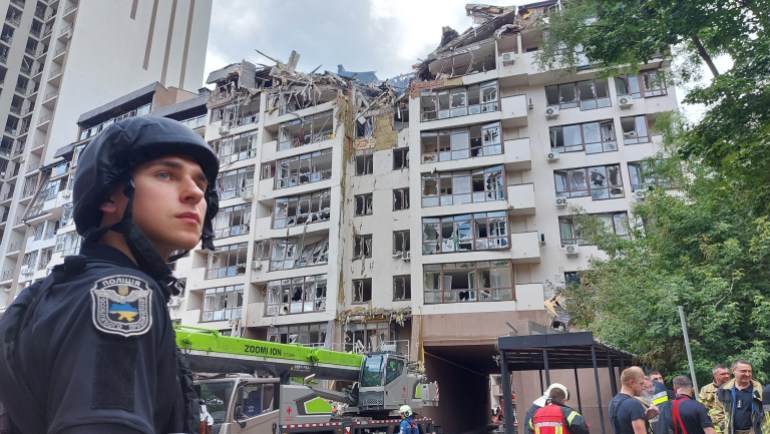Kiev -
Russia's war on Ukraine is ending its sixth month, thus becoming the longest war the European continent has witnessed in decades, and the most terrible in terms of widespread destruction and the deaths of tens of thousands of dead and wounded, in addition to the internal displacement of millions or their asylum to European neighboring countries and others.
On the ground, the past six months witnessed a rapid advance of the Russian forces into the Ukrainian depth, and a significant control over large areas of the Sumy, Chernihiv and Kiev regions in the north, as well as over the Kharkiv regions in the east, and Zaporozhye and Kherson in the south.
But the end of last March witnessed a major shift in the course of the war with the withdrawal of the Russians from the north and most of the Kharkiv region, which Kyiv considered "liberation" under the impact of its forces' strikes.
In the previous June, Ukraine announced "counter-operations" in the south to regain control over parts that fell into the hands of the Russians in the Zaporozhye region, almost the entire Kherson region and parts of neighboring Mykolaiv, and even Crimea, which Russia occupied in 2014.
But this did not prevent the fact that the Russians’ focus on the southeastern Donbass region made Ukraine lose control of the entire Luhansk region and major cities in it and in the neighboring Donetsk region, some of which were completely or partially leveled, such as Mariupol, Severodonetsk and Lyschansk, and completely deprived it of overlooking the Sea of Azov. .
Extensive destruction in Ukrainian buildings and facilities as a result of the Russian attacks (Al-Jazeera)
Tens of thousands of soldiers from both sides were killed
And because they are the fuel of war and its first victims, the number of Ukrainian soldiers killed, according to Chief of Staff Valery Zalogny, has risen to about 9,000 since the start of the war on February 24, 2022, amid talk of tens of thousands more being injured.
And mostly in Ukraine is the concealment of the numbers of dead and injured, but both the General Staff and the Ministry of Defense update daily the statistics of losses in the ranks of the Russian forces, which include - until the date of August 23 this year - the killing of about 45 thousand and 400 soldiers, and the destruction or damage of 1919 tanks, 4,230 armored vehicles, and 3,149 other military vehicles.
In addition to the destruction of 1,032 artillery systems, 145 air defense systems, 234 combat aircraft, 198 helicopters, 815 drones, 194 cruise missiles, and 15 ships, most notably the cruiser "Moskva".
Retired colonel and military expert Serhi Hrabsky told Al Jazeera Net, "If these numbers are correct, we have about 40 thousand wounded, and the Russians have at least 100 thousand, because the number of casualties in such large-scale wars exceeds the number of dead by about 3.5 to 4 times."
A Ukrainian family bids farewell to their military son who was killed in a Russian bombing (Reuters)
Thousands of victims and millions of displaced people and refugees
According to the latest data of the United Nations Human Rights Office, Russia's war has claimed about 13,500 civilian casualties in Ukraine, including about 8,000 wounded.
According to the Ukrainian Emergency Service, the war claimed the lives of 374 children, and injured 723 children, most of them children of the Donetsk region.
Since the beginning of the war, UNHCR has recorded 11 million border crossings from Ukraine, and 4.7 million in the opposite direction;
Most of the Ukrainian refugees are women and children, with men still being prevented from traveling under the declared "state of war".
The United Nations estimates that 12 million people inside Ukraine need support after they have been displaced or lost their homes and businesses.
Thus, the war has cast a shadow over about 45% of the country's estimated population of 42 million people before the war.
Infrastructure damage and economic losses
According to the Kyiv Institute of Economics, 6 months of war caused direct losses to the country's economy estimated at 113.5 billion dollars.
These repercussions prompted the government to launch the "Defense, Reform and Reconstruction" project to raise $750 billion in global support.
The Ukrainian infrastructure losses include damage to about 131.3 thousand square kilometers of houses and apartments, 24,800 km of paved roads, 12 civilian airports, 12 military airports, and two ports.
The losses also include 934 health care institutions, 2290 educational institutions, 511 administrative buildings, and 715 cultural buildings.
As the war continues, the National Bank of Ukraine expects the country's economy to decline by 30% this year, while the Ministry of Economy expects the loss of GDP to reach about $112 billion by the end of the year, a decline of about 20%, to reach $1.2 trillion in 2030.
The reason for this is the continued blockade of most Ukrainian ports, which are considered the window of Ukraine's main exports to the world, and a decline in agricultural production by an expected rate of 30%, despite the glimmer of hope that the Istanbul agreement for the release of Ukrainian grain on July 22 last.

